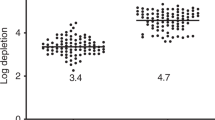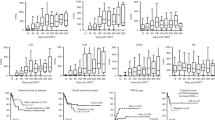Summary:
Peritransplant toxicity and a delay in effective immune reconstitution have limited the utility of alternate donor transplantation for children with refractory severe aplastic anemia. We have assessed the effectiveness of infusing large numbers of highly purified haploidentical CD34+ cells after immunoablative conditioning in three patients who had failed intensive immunosuppression, lacked unrelated donors, and had active or recent serious infections. One patient rejected the first infusion, but engrafted after a second infusion from the same donor. This patient died 4 months after hematopoietic stem cell transplantation with no evidence of lymphoid reconstitution. Two patients experienced mixed chimerism requiring treatment with antibodies and/or donor lymphocyte infusion. Both currently survive more than 1 year after transplantation with normal blood counts, 100% donor engraftment, effective lymphoid reconstitution, and no chronic graft-versus-host disease. We observed functional thymopoiesis as measured by lymphocyte immunophenotyping, T cell receptor excision circles and T cell receptor Vβ spectratyping complexity analysis. Further study is required to validate the initial promise of these preliminary observations.
This is a preview of subscription content, access via your institution
Access options
Subscribe to this journal
Receive 12 print issues and online access
$259.00 per year
only $21.58 per issue
Buy this article
- Purchase on Springer Link
- Instant access to full article PDF
Prices may be subject to local taxes which are calculated during checkout

Similar content being viewed by others
References
Sanders JE, Storb R, Anasetti C et al. Marrow transplant experience for children with severe aplastic anemia. Am J Pediatr Hematol/Oncol 1994; 16: 43–49.
Margolis D, Camitta B, Pietryga D et al. Unrelated donor bone marrow transplantation to treat severe aplastic anemia in children and young adults. Br J Haematol 1996; 94: 65–72.
Davies SM, Wagner JE, Defor T et al. Unrelated donor bone marrow transplantation for children and adolescents with aplastic anaemia or myelodysplasia. Br J Haematol 1997; 96: 749–756.
Wagner JL, Deeg HJ, Seidel K et al. Bone marrow transplantation for severe aplastic anemia from genotypically HLA-nonidentical relatives. An update of the Seattle experience. Transplantation 1996; 61: 54–61.
Deeg HJ, Amylon MD, Harris RE et al. Marrow transplants from unrelated donors for patients with aplastic anemia: minimum effective dose of total body irradiation. Biol Blood Marrow Transplant 2001; 7: 208–215.
Aversa F, Tabilio A, Terenzi A et al. Successful engraftment of T-cell-depleted haploidentical ‘three-loci’ incompatible transplants in leukemia patients by addition of recombinant human granulocyte colony-stimulating factor-mobilized peripheral blood progenitor cells to bone marrow innoculum. Blood 2002; 84: 3948–3955.
Aversa F, Terenzi A, Carotti A et al. Improved outcome with T-cell-depleted bone marrow transplantation for acute leukemia. J Clin Oncol 1999; 17: 1545–1550.
Handgretinger R, Klingebiel R, Lang P et al. Megadose transplantation of purified peripheral blood CD34+ progenitor cells from HLA-mismatched parental donors in children. Bone Marrow Transplant 2001; 27: 777–783.
Schwinger W, Urban C, Lackner H et al. Unrelated peripheral blood stem cell transplantation with ‘megadoses’ of purified CD34+ cells in three children with refractory severe aplastic anemia. Bone Marrow Transplant 2002; 25: 513–517.
Urban CE, Schwinger WE, Sykora KW et al. Unrelated and mismatched family donor SCT with highly purified peripheral CD34+ cells in children with SAA refractory to immunosuppressive therapy. Blood 2001; 98: 675a; ASH 2001, Orlando, FL (C562).
Speiser DE, Hermans J, van Biezen A et al. Haploidentical family member transplants for patients with chronic myeloid leukemia: a report of the Chronic Leukaemia Working Party of the European Group for Blood and Marrow Transplantation (EBMT). Bone Marrow Transplant 1997; 19: 1197–1203.
Kato S, Yabe H, Yasui M et al. Allogeneic hematopoietic transplantation of CD34+ selected cells from an HLA haplo-identical related donor. A long-term follow-up of 135 patients and a comparison of stem cell source between the bone marrow and the peripheral blood. Bone Marrow Transplant 2000; 26: 1281–1290.
de Witte T, Pikkemaat F, Hermans J et al. Genotypically nonidentical related donors for transplantation of patients with myelodysplastic syndromes: comparison with unrelated donor transplantation and autologous stem cell transplantation. Leukemia 2001; 15: 1878–1884.
Szydlo R, Goldman JM, Klein JP et al. Results of allogeneic bone marrow transplants for leukemia using donors other than HLA-identical siblings. J Clin Oncol 1997; 15: 1767–1777.
Andolina M, Maximova N, Rabusin M et al. Haploidentical bone marrow transplantation in leukemia and genetic disease. Haematologica 2000; 85 (Suppl. 11): 37–40.
Drobyski W, Klein J, Flomenberg N et al. Superior survival associated with transplantation of matched unrelated versus one-antigen-mismatched unrelated or highly human leukocyte antigen-disparate haploidentical family donor marrow grafts for the treatment of hematologic malignancies: establishing a treatment algorithm for recipients of alternative donor grafts. Blood 2002; 99: 806–814.
Eyrich M, Lang P, Lal S et al. A prospective analysis of the pattern of immune reconstitution in a paediatric cohort following transplantation of positively selected human leucocyte antigen-disparate haematopoietic stem cells from parental donors. Br J Haematol 2001; 114: 422–432.
Ortin M, Raj R, Kinning E et al. Partially matched related donor peripheral blood progenitor cell transplantation in paediatric patients adding fludarabine and anti-lymphocyte gamma-globulin. Bone Marrow Transplant 2002; 30: 359–366.
Handgretinger R, Klingebiel T, Lang P et al. Megadose transplantation of highly purified haploidentical stem cells: current results and future prospects. Pediatr Transplant 2003; 7 (Suppl. 3): 51–55.
Kremens B, Basu O, Grosse-Wilde H et al. Transplantation of CD34-enriched peripheral stem cells from an HLA-haplotype mismatched donor to a patient with severe aplastic anemia. Bone Marrow Transplant 2001; 27: 111–113.
Hazenberg MD, Otto SA, Cohen Stuart JW et al. Increased cell division but not thymic dysfunction rapidly affects the T-cell receptor excision circle content of the naive T cell population in HIV-1 infection. Nat Med 2000; 6: 1036–1042.
Yassai M, Bull M, Gorski J . Analysis of human T-cell receptor alpha-chain cDNAs isolated from peripheral blood mononuclear cells. Hum Immunol 1992; 34: 279–283.
Yassai M, Hletko A, Gorski J . Forces molding circulating T-cell repertoires. Thymic events studied by recombination analysis. Ann NY Acad Sci 1995; 756: 81–83.
van der Mast BJ, van Besouw NM, Witvliet MD et al. Formation of donor-specific human leukocyte antigen antibodies after kidney transplantation: correlation with acute rejection and tapering of immunosuppression. Transplantation 2003; 75: 871–877.
Bishara A, Brautbar C, Eid A et al. Is presensitization relevant to liver transplantation outcome? Hum Immunol 2002; 63: 742–750.
Bishara A, Admon D, Sherman L, Brautbar C . Detection of anti-HLA antibodies by ELISA: relevance to heart transplantation. Transplant Proc 2001; 33: 2909.
Tschernia A, LeLeiko NS, Grima K et al. Anti-HLA antibody removal by extracorporeal immunoadsorption in two hyperimmunized pediatric patients awaiting hepatointestinal transplantation. Transplant Proc 2002; 34: 900–901.
Min CK, Kim DW, Lee JW et al. Additional stem cell therapy for graft failure after allogeneic bone marrow transplantation. Acta Haematol 2000; 104: 185–192.
Nagler A, Ackerstein A, Kapelushnik J et al. Donor lymphocyte infusion post-non-myeloablative allogeneic peripheral blood stem cell transplantation for chronic granulomatous disease. Bone Marrow Transplant 1999; 24: 339–342.
Selleri C, Raiola A, De Rosa G et al. CD34+-enriched donor lymphocyte infusions in a case of pure red cell aplasia and late graft failure after major ABO-incompatible bone marrow transplantation. Bone Marrow Transplant 1998; 22: 605–607.
Lowdell MW, Craston R, Ray N et al. The effect of T cell depletion with Campath-1M on immune reconstitution after chemotherapy and allogeneic bone marrow transplant as treatment for leukaemia. Bone Marrow Transplant 1998; 21: 679–686.
Kook H, Goldman F, Padley D et al. Reconstruction of the immune system after unrelated or partially matched T-cell-depleted bone marrow transplantation in children: immunophenotypic analysis and factors affecting the speed of recovery. Blood 1996; 88: 1089–1097.
Small TN, Papadopoulos EB, Boulad F et al. Comparison of immune reconstitution after unrelated and related T-cell-depleted bone marrow transplantation: effect of patient age and donor leukocyte infusions. Blood 1999; 93: 467.
Acknowledgements
We would like to express their appreciation to the BMT Clinical Research Office for data management and to the BMT practitioners for patient care. This work was supported in part by NIH Cancer Center Support Grant P 30CA 21765 and the American Lebanese Syrian Associated Charities (ALSAC).
Author information
Authors and Affiliations
Corresponding author
Rights and permissions
About this article
Cite this article
Woodard, P., Cunningham, J., Benaim, E. et al. Effective donor lymphohematopoietic reconstitution after haploidentical CD34+-selected hematopoietic stem cell transplantation in children with refractory severe aplastic anemia. Bone Marrow Transplant 33, 411–418 (2004). https://doi.org/10.1038/sj.bmt.1704358
Received:
Accepted:
Published:
Issue Date:
DOI: https://doi.org/10.1038/sj.bmt.1704358
Keywords
This article is cited by
-
Combination of haploidentical haematopoietic stem cell transplantation with an unrelated cord-blood unit in patients with severe aplastic anemia: a report of 146 cases
Bone Marrow Transplantation (2020)
-
Cotransplantation of bone marrow-derived mesenchymal stem cells in haploidentical hematopoietic stem cell transplantation in patients with severe aplastic anemia: an interim summary for a multicenter phase II trial results
Bone Marrow Transplantation (2017)
-
Immune reconstitution in patients with acquired severe aplastic anemia after haploidentical stem cell transplantation
Bone Marrow Transplantation (2017)
-
Haploidentical BMT and post-transplant Cy for severe aplastic anemia: a multicenter retrospective study
Bone Marrow Transplantation (2015)
-
The diagnosis and treatment of aplastic anemia: a review
International Journal of Hematology (2015)



